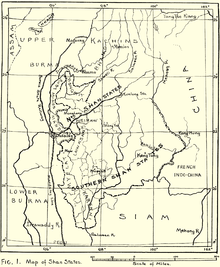

| Kengcheng State | |||||||||||
|---|---|---|---|---|---|---|---|---|---|---|---|
| State of the Shan States | |||||||||||
| 18th century–1896 | |||||||||||
 | |||||||||||
| History | |||||||||||
• Foundation of the state | 18th century | ||||||||||
• Division of the state | 1896 | ||||||||||
| |||||||||||
KengchengorKeng Cheng (also known as Kyaingchaing and Chiang Khaeng) was one of the Shan states. In 1896, part of Keng Cheng was incorporated into the neighbouring state of Kengtung in what is today Burma, and the other part, which is now in Laos, went to French Indochina.[1]
Kengcheng was a tributary state of the King of Burma until 1887, when the Shan states submitted to British rule after the fall of the Konbaung dynasty. The capital of Keng Cheng was at Muang Sing (now part of Laos).[2]
In 1896, Kengcheng was divided between British Burma and French Indochina with the Mekong as a border. The districts of the Cis-Mekong part of the state were merged with Kengtung State and the eastern districts, now the Muang Sing area, went first to Siam and then to the French. The limit between Kengtung and China was demarcated by an Anglo-Chinese commission in 1898–1899.[3]
Sir George Scott mentioned the following about the Keng Cheng Myosa:[4]
This was the unfortunate man who was told that he belonged to Siam and then that he didn't. Half his territory finally handed over to France.
The rulers of Kengcheng had the title Ngwegunhmu and by c. 1880, it changed to Myoza.[5]
|
Shan States and related petty kingdoms
| |
|---|---|
| Northern Shan States |
|
| Southern Shan States Eastern Division |
|
| Southern Shan States Central Division |
|
| Southern Shan States Myelat Division |
|
| Southern Shan States Kengtung & Yawnghwe |
|
| Chinese Shan States |
|
| Related states and outliers |
|
| |
21°21′N 100°52′E / 21.350°N 100.867°E / 21.350; 100.867
This Burmese history article is a stub. You can help Wikipedia by expanding it. |
This Shan State location article is a stub. You can help Wikipedia by expanding it. |